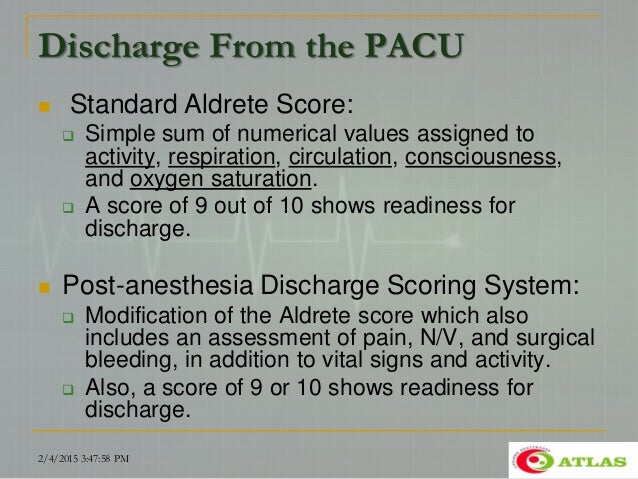Health Information Management
Change Category
- Health Information Management
Articles by Publication
Articles by Topic
Resources
Store
Follow these guidelines when developing a PACU policy and procedure. QUESTION: We are working on a policy and procedure for our post anesthesia care unit (PACU) and would like to know when it is appropriate to charge recovery services post procedure. A manual of PACU readings will be provided at the start of the rotation. At the conclusion of the rotation, the resident should be able to:. Describe options for a patient’s pain relief in the postoperative period, including pharmacologic and other techniques. Welcome PACU nurses to the Perioperative Core Orientation! Your instructions for successfully completing this orientation is as follows: You are required to complete the required e-Modules which will be found on the iLearn. You must complete the posttest with a score of 100%.
- Home
- » Health Information Management Main Page
- » e-Newsletters
- » APCs Insider
- » e-Newsletters
- » Health Information Management Main Page
APCs Insider, September 9, 2005
Want to receive articles like this one in your inbox? Subscribe to APCs Insider!
Follow these guidelines when developing a PACU policy and procedure
QUESTION: We are working on a policy and procedure for our post anesthesia care unit (PACU) and would like to know when it is appropriate to charge recovery services post procedure.
For example, is it appropriate to charge PACU for gastrointestinal (GI) lab procedures that a physician performs during surgery, and the patient recovers in our PACU? For a GI lab procedure performed and recovered in our GI lab? How about for bronchoscopy procedures that a physician performs in surgery and after which the patient recovers in PACU?
Also, what documentation is necessary to support PACU charges? For example, is an MD order appropriate, even though surgery does not use one? Should our policy and procedure factor in facility and JCAHO guidelines, staffing issues, and location of care?
ANSWER: The justification for PACU begins with medical necessity. To our knowledge, there are no LMRPs for PACU. Therefore, consider the medical needs for a patient in PACU. Typically, staff will monitor the patient's airway (oxygen sat, respiratory, etc.), circulation (blood pressure, heart rate), bleeding (or other complication resulting from procedure including pain), temperature, urine output, medication toleration, and conscious level.
If the patient doesn't develop complications or problems in these areas in the first hour they are unlikely to develop any at all, and you can discharge the patient. The key to PACU is that this area of the hospital has the equipment and staffing levels to provide very close monitoring of these facets of a patient's condition.
It is difficult to categorically state that all patients undergoing a specific procedure will require PACU, particularly with simpler/less complex procedures. One may argue that the less invasive/lower anesthesia/shorter duration procedure won't need PACU at all. The problem is that each person is unique, and we must allow for special cases or unusual reactions. The best that we can do is state that under normal circumstances, a patient undergoing a particular procedure doesn't require time in the PACU (even though this can depend on the discharge criteria from the operating room).
One rule of thumb to consider is that if the physician can perform the procedure in a treatment room, rather than the OR, it is likely that the patient will not need to recover in the PACU. In larger hospitals with treatment rooms that rival OR rooms, this general rule may not apply.
However you must consider why a physician performs a procedure in the OR. Did he or she perform it in the OR because the patient needed that level of care? Did the physician need access to equipment/staff at that level? Or did he or she perform it because it is the most convenient location? Given all these disclaimers, we would say generally speaking from a medical necessity perspective GI/bronchoscopy procedures do not require PACU time.

Regarding documentation, often times physicians do not document procedures. Occasionally, for major procedures, you will see one on the order sheet. Your facility will likely meet the basic requirement for PACU if it has standing orders which direct certain patients based upon either the procedure they had or symptoms they had to the PACU. The same holds true for discharge criteria. In order for staff to discharge a patient from the PACU, they should meet clear objectives, otherwise you will find that the payer will debate the length of time in PACU.
Location is important. To be classified a PACU or recovery room, the area must provide a certain level of care (i.e. to be able to monitor the criteria discussed in paragraph one). The location can be the same place where the physician performed the procedure, provided the level of care is commensurate with the PACU. Once the care level drops to that which is typically seen in an outpatient or medical floor, then it is no longer considered PACU.
Want to receive articles like this one in your inbox? Subscribe to APCs Insider!
Related Products
Briefings on APCs
Worried about the complexities of the new rules under OPPS and APCs? Briefings on APCs helps you understand the new rules...
HIM Briefings
Guiding Health Information Management professionals through the continuously changing field of medical records and toward a...
Briefings on Coding Compliance Strategies
Submitting improper Medicare documentation can lead to denial of fees, payback, fines, and increased diligence from payers...
Briefings on HIPAA
How can you minimize the impact of HIPAA? Subscribe to Briefings on HIPAA, your health information management resource for...
APCs Insider
This HTML-based e-mail newsletter provides weekly tips and advice on the new ambulatory payment classifications regulations...
Most Popular
Pacu Orientation Manual
- Articles
- E-mailed
- Searched
Comments are closed.